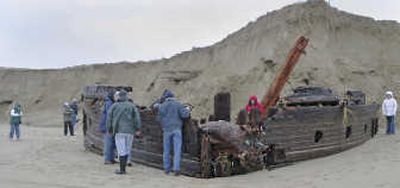Dunes reveal mystery ship

COOS BAY, Ore. – Talk to any locals and they’ll say plenty about this winter’s storms. The big waves. The heavy rains.
“I don’t remember this much wind and rain,” said Jack Hammar, as his pickup truck bounced and bumped on Coos Bay’s North Spit.
Hammar was leading a caravan of family and acquaintances packed into two 4-wheel-drive pickup trucks and a Jeep. They scooted along the seawall road toward the beach to investigate a mystery ship.
This season’s wind and waves have shifted a mountain of sand day after day, uncovering the 35-foot-long bow of a wooden-hulled vessel.
Ask folks who’ve played on the North Spit for decades, and they’ll tell you they’ve never seen a wrecked ship quite like this.
At first, there was just a tip. Then, storm after storm, the big ship bow materialized, as fast, it seems, as people’s memories of it faded away.
“I’ve been coming out here since I was old enough to remember – about 6 years old,” said the 47-year-old Hammar. “I’ve never seen this up until this winter.”
“This thing is built on such a massive scale. It blows my mind,” Hammar said.
The bow’s sides protrude up from the sand below a towering dune. They’re more than a foot thick. Vertical timbers that run through the walls are lined on both sides by planking. All are tied together with iron bars and pins. There appear to be square portholes cut through the sides every six feet or so.
Curved chair-size ribs rise out of the sand on the insides anchored by more iron bars, but the top deck is gone. It was a two-deck vessel. A schooner at least for a time. But its use is unclear.
Local historians have no idea whose ship it was or when it ran aground, at least not yet.
“It seems to be from the late 1800s and early 1900s. There’s some evidence it was a sailing ship, but then there’s some evidence it was converted to a coastal barge,” said Steve Samuels, the Bureau of Land Management’s cultural resource coordinator.
There’s a small pipe in one side that appears to be from a bilge pump. He estimated another 15 feet of the keel rests deep in the sand.
Archaeologists were beside the vessel on a recent afternoon: Samuels and Reg Pullen of BLM, as well as Oregon State Parks’ Calum Stevenson.
They say there are ways to guess a ship’s age and provenance.
It appears possibly to have been built with some Douglas fir, which would be indicative of the Pacific Northwest. There were shipbuilding outfits small and large up and down the Oregon and California coasts, including at Coos Bay and North Bend.
All wooden ships had some sort of caulking, Stevenson explained.
“Older ships had a cotton and then a kind of tar pitch liquid that was put in,” he said.
Later, shipbuilders employed a white leaded paste.
“It looks like a white lead paste kind of caulking on this ship, so that would probably date it to the 19th century,” Stevenson said.
The bow points west to the ocean, which is unusual for shipwrecks. It’s on a legally fuzzy dividing line between Oregon State Parks and U.S. Bureau of Land Management jurisdiction. There are no plans at this point to save it.
“Once it’s been exposed like it is, it’s going to deteriorate fairly rapidly,” Samuels said.
Some have speculated the bow is part of the Czarina that foundered on the Coos Bay Bar and drifted north toward Horsfall 98 years ago. But that ship was metal-hulled. Others have suggested it’s the lumber-carrying C.A. Smith, which ran aground and broke up at the North Jetty in 1923.
Dreamers would like to have it be the historically rich Captain Lincoln. In January 1852, that wood-hulled ship ran ashore at the Coos Bay estuary. The ship was bringing supplies to military outposts in the Oregon Territory. The crew spent four months camped on the spit trading with local Indians. But this shipwreck evidence doesn’t point that way.
And there may not be much time for on-the-sand research.
For a hundred years or more, it’s been preserved in hard-packed sand and protected by the salt water. But now, exposed to the air, worms and other small critters will get at it, not to mention the waves that slam logs and debris daily into the splitting wood with the coming and going of the tide.
Come March 15, the end of the spit, the dry sand portion and upland will be closed for the six-month snowy plover breeding season. There won’t be special permits for archaeologists. Come September, they will have the short window before winter to learn all they can about the ship.
“We would appreciate any marine architects with historical knowledge to contact us. It might have been something that was built here, but we don’t know,” Samuels said.
And locals, too, are encouraged to share their historical knowledge and stories.
At the site, 82-year-old Lillas Bledsoe calmly poked around the uncovered bow. She sniffed at the splintered wood. “Sea rot,” she said.
She came out to the spit to see whether the ship remains were the same as some she remembered from years ago.
After the war, she recalled, her ex-husband “Babe” Johnson and five other men took a mule team out on the spit. They towed a wagon to salvage lumber from a wrecked barge. That was maybe 1946 or 1947.
“No, this isn’t the one,” she said of the shipwreck.
She said she might have recalled seeing it those many years ago covered with sand. Then again, maybe not.
Locals and historians have been visiting this site day after day, trying to learn all they can about the mystery shipwreck that seems destined to fade away.